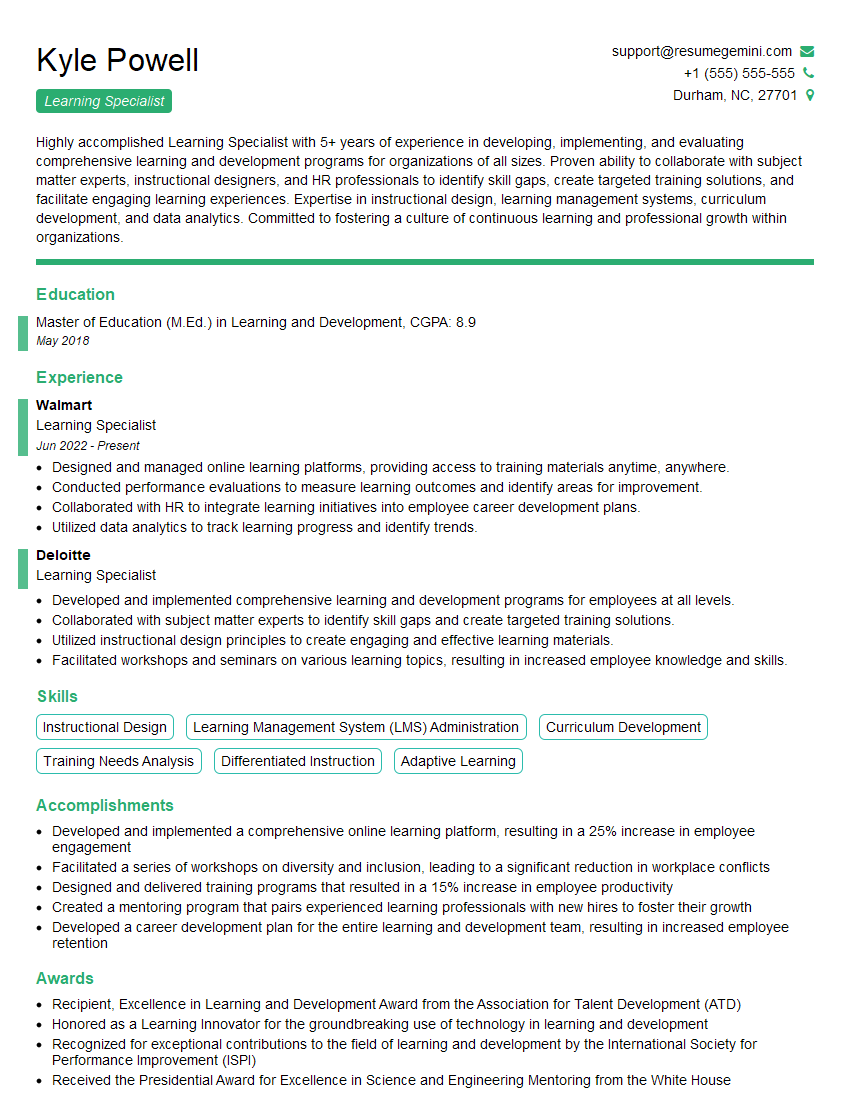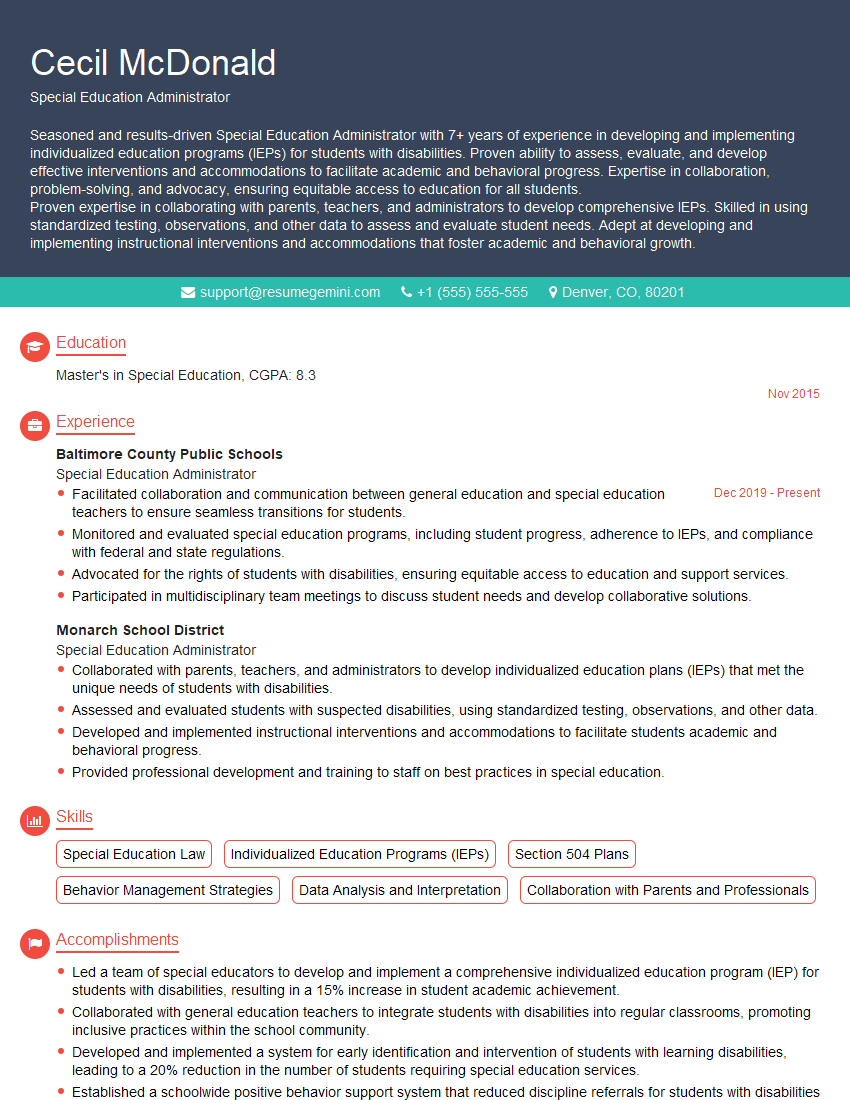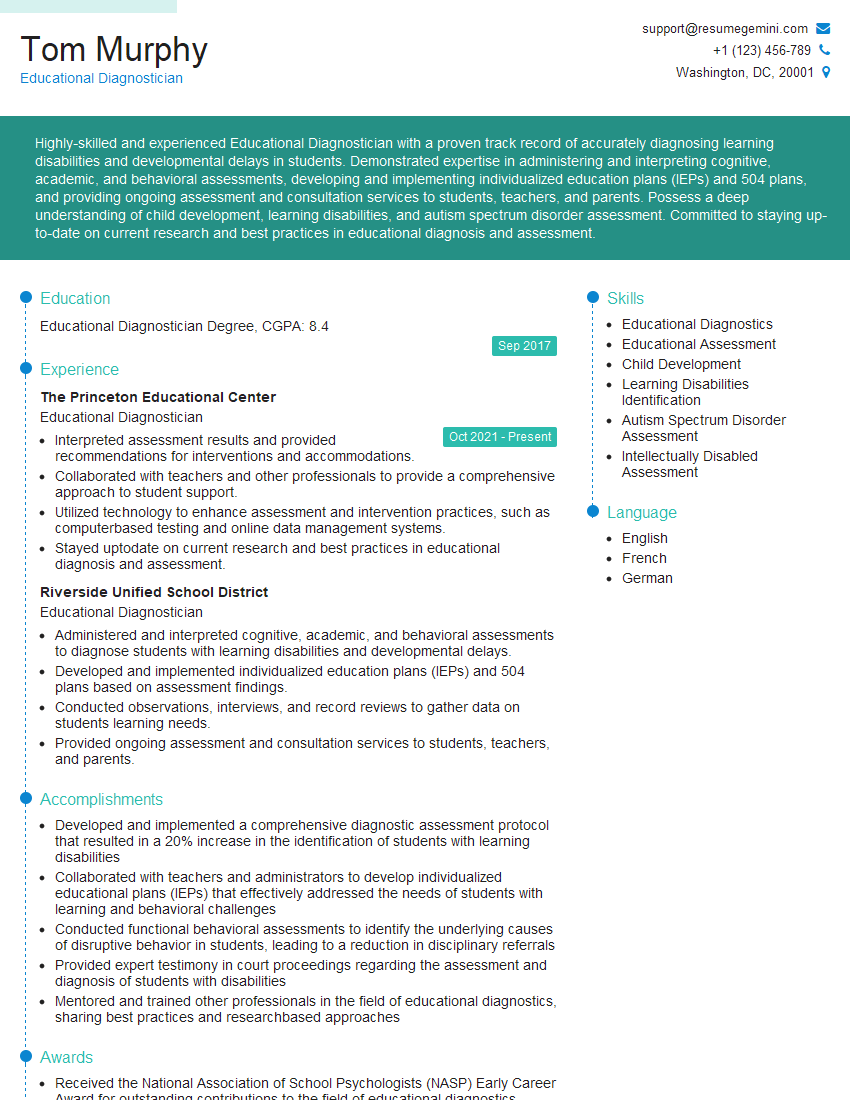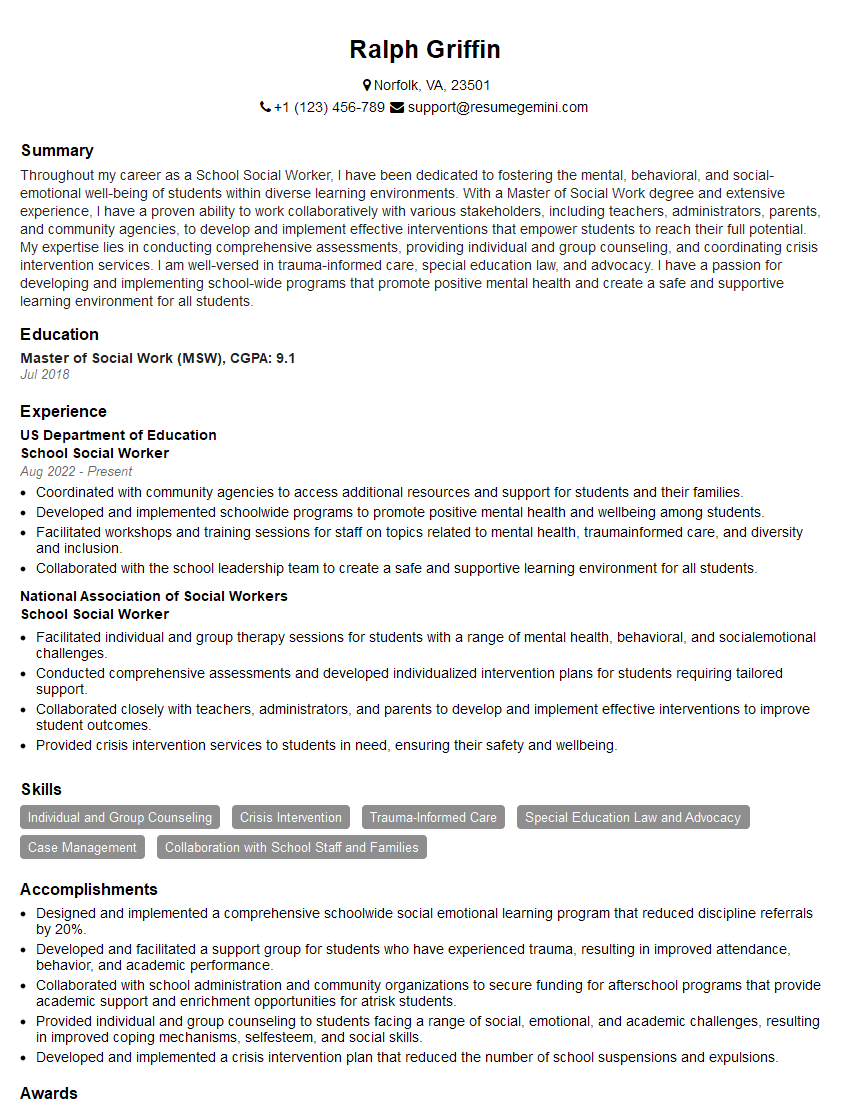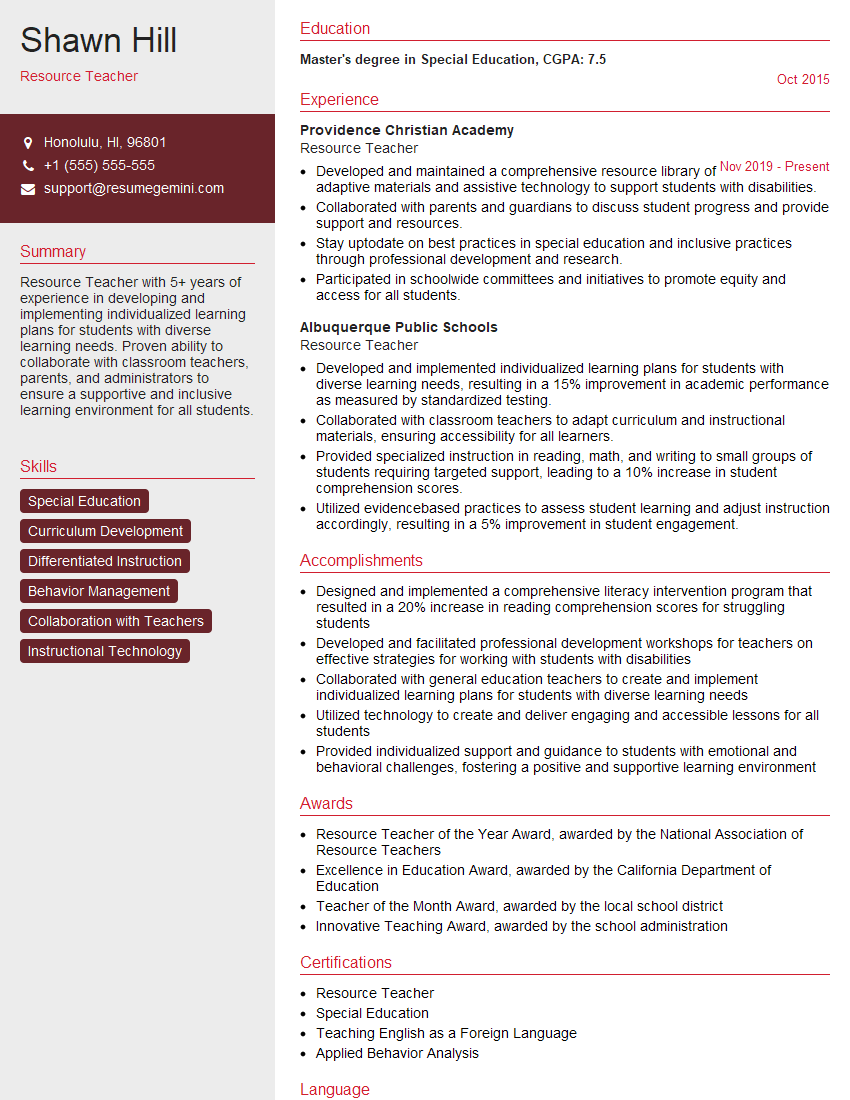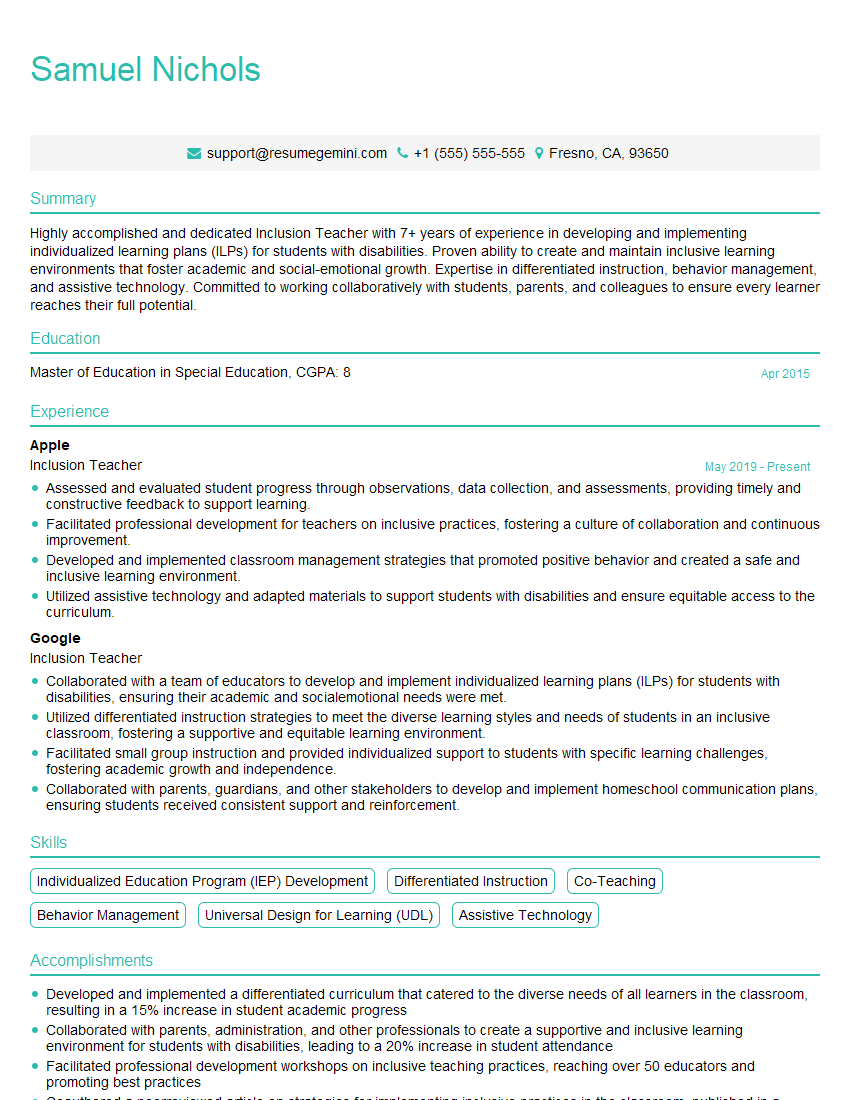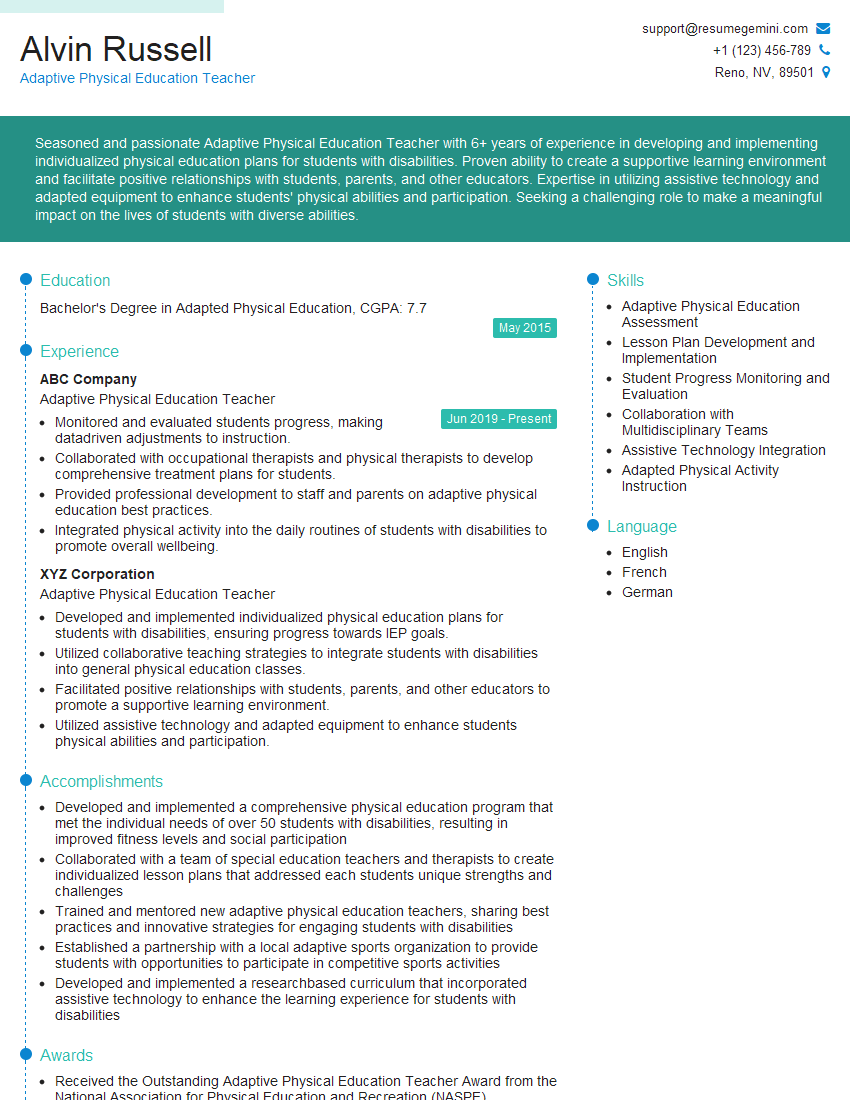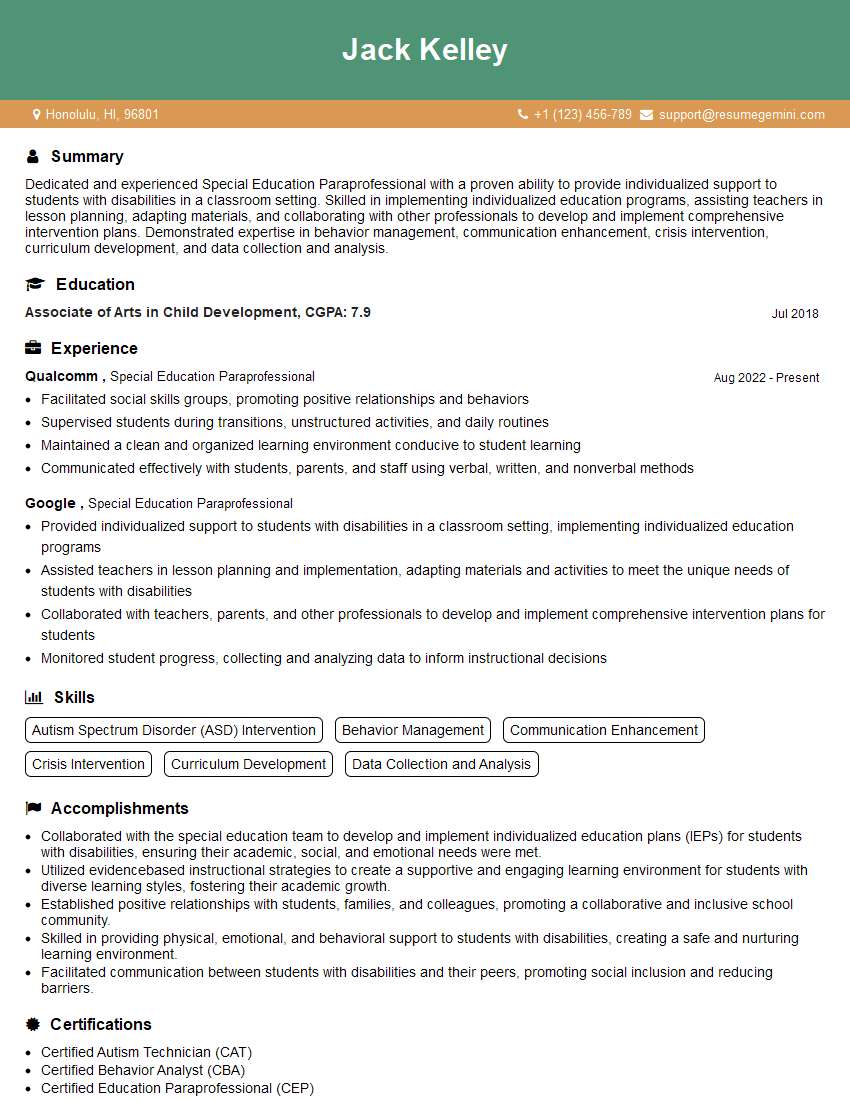Unlock your full potential by mastering the most common IEP and 504 Plan Development interview questions. This blog offers a deep dive into the critical topics, ensuring you’re not only prepared to answer but to excel. With these insights, you’ll approach your interview with clarity and confidence.
Questions Asked in IEP and 504 Plan Development Interview
Q 1. Define the difference between an IEP and a 504 plan.
IEPs and 504 plans both aim to support students with disabilities, but they differ significantly in their scope and implementation. An Individualized Education Program (IEP) is a legally binding document for students with disabilities who require specialized instruction and related services to access their education. It’s developed under the Individuals with Disabilities Education Act (IDEA), a federal law. In contrast, a 504 plan is a plan developed under Section 504 of the Rehabilitation Act of 1973. It addresses students with disabilities who require accommodations to access the general education curriculum but don’t necessarily need specialized instruction. Think of it this way: an IEP is like a specialized learning pathway designed for students needing significant educational modifications, while a 504 plan is more like a ramp built to make the existing building accessible.
Key Differences Summarized:
- Legal Basis: IEP (IDEA), 504 Plan (Rehabilitation Act of 1973)
- Instructional Needs: IEP addresses significant learning needs requiring specialized instruction; 504 addresses needs that can be met with accommodations in the general education setting.
- Eligibility Determination: IEP requires a formal evaluation and determination of eligibility under specific disability categories; 504 requires documentation showing a disability that substantially limits one or more major life activities.
- Team Involvement: IEP involves a multidisciplinary team including parents, educators, and specialists; 504 plan typically involves a smaller team, often including the parent, teacher, and school administrator.
Q 2. What are the key components of an effective IEP?
An effective IEP has several crucial components working together to ensure a student’s success. Think of it as a blueprint for the student’s education, customized to their specific needs.
- Present Levels of Performance (PLP): A detailed description of the student’s current academic, social, emotional, and behavioral strengths and weaknesses. This is the baseline to track progress.
- Goals and Objectives: Measurable and achievable goals that outline what the student will learn and accomplish within a specific timeframe. These should be SMART: Specific, Measurable, Achievable, Relevant, and Time-bound.
- Services and Accommodations: Specific services and accommodations the student will receive to help them meet their goals. This might include specialized instruction, assistive technology, or modifications to assignments.
- Evaluation and Progress Monitoring: A plan for regularly monitoring the student’s progress toward their goals and making adjustments to the IEP as needed. This involves regular meetings, data collection, and progress reports.
- Transition Services (for secondary students): Planning for the student’s transition to post-secondary education, employment, or independent living. This is crucial for preparing students for life after high school.
Example: A student struggling with reading might have a goal to improve their reading fluency by 10 words per minute over the next six months. The accommodations might include preferential seating, access to audiobooks, and targeted reading intervention.
Q 3. Describe the process of developing an IEP.
The IEP development process is a collaborative effort involving several key players. It’s a cyclical process, meaning the IEP is reviewed and updated regularly.
- Referral and Evaluation: The process starts with a referral, often from a teacher or parent, expressing concerns about a student’s learning. This is followed by a comprehensive evaluation to determine if the student has a disability and the nature of their needs.
- IEP Meeting: Once eligibility is determined, an IEP meeting is scheduled. This meeting includes the parents, educators, specialists (e.g., psychologist, occupational therapist), and the student (if appropriate). The team works together to develop the IEP.
- IEP Development: The team collaboratively discusses the PLP, sets goals, determines appropriate services and accommodations, and establishes a plan for progress monitoring.
- IEP Implementation: The IEP is put into action. Teachers, specialists, and other support staff implement the plan and provide the necessary services and accommodations.
- Progress Monitoring and Review: Regular meetings are held to monitor the student’s progress. Based on the progress data, adjustments are made to the IEP as needed. Annual reviews are conducted to reassess the student’s needs and update the IEP.
Q 4. Explain the role of parents/guardians in the IEP process.
Parents/guardians play a vital role in the IEP process. They are considered equal partners in decision-making and have the right to participate fully in all aspects of their child’s IEP development and implementation.
- Active Participation in Meetings: Parents are entitled to attend all IEP meetings, participate in discussions, and contribute their insights and perspectives.
- Consent and Informed Decision-Making: Parents must give informed consent before any evaluations or services are provided. They have the right to refuse any part of the IEP they do not agree with.
- Access to Information: Parents have the right to review all documents related to their child’s evaluation and IEP.
- Advocacy for their Child: Parents have the right to advocate for their child’s needs and ensure the IEP meets their child’s individual requirements.
Example: A parent might advocate for specific assistive technology based on their child’s needs or request specific types of therapy.
Q 5. How do you determine appropriate accommodations for a student with a 504 plan?
Determining appropriate accommodations for a student with a 504 plan involves a thorough assessment of their needs and how their disability affects their ability to access the general education curriculum. The process typically involves:
- Identification of the disability: Documentation of the student’s disability that substantially limits one or more major life activities is necessary.
- Functional Assessment: This determines how the disability impacts the student’s academic performance and participation in school activities. This could involve observations, interviews, and review of existing data.
- Collaboration and Planning: The 504 team, usually consisting of the parent, teacher, and school administrator, collaboratively identifies accommodations that will enable the student to succeed in the general education environment. These accommodations should be evidence-based and address the specific limitations identified in the functional assessment.
- Implementation and Monitoring: The accommodations are implemented, and the effectiveness is regularly monitored. The 504 plan can be adjusted as needed.
Example: A student with ADHD might benefit from preferential seating, shorter assignments, and frequent breaks, all of which can be included in their 504 plan.
Q 6. What are some common accommodations used in IEPs and 504 plans?
Many common accommodations are used in both IEPs and 504 plans, depending on the student’s individual needs. These accommodations aim to create a more accessible and supportive learning environment.
- Instructional Accommodations: Modified assignments, alternative assessments, extended time on tests, preferential seating, use of assistive technology.
- Environmental Accommodations: Quiet testing environment, reduced distractions, adjusted lighting, flexible scheduling.
- Assistive Technology: Text-to-speech software, speech-to-text software, graphic organizers, calculators.
- Behavioral Supports: Positive behavior interventions and supports (PBIS), behavior management strategies, counseling services.
Example: A student with a visual impairment might receive large-print materials, audio books, and preferential seating, while a student with anxiety might be allowed to take tests in a separate room.
Q 7. How do you monitor the effectiveness of an IEP or 504 plan?
Monitoring the effectiveness of an IEP or 504 plan is crucial to ensure the student’s needs are being met and the plan is making a positive impact. This involves ongoing data collection and analysis, regular communication, and adjustments as needed.
- Regular Progress Monitoring: Frequent data collection is essential. This can involve tracking grades, completion of assignments, participation in class, and behavioral data. The frequency of monitoring depends on the student’s needs and the goals set in the plan.
- Data-Based Decision-Making: The data collected should inform decisions about whether the current accommodations and supports are effective and whether adjustments are necessary.
- Review Meetings: Regular meetings are essential to review progress, discuss the data, and make adjustments to the IEP or 504 plan as needed. These meetings involve the same team that developed the plan.
- Communication: Open and regular communication between teachers, parents/guardians, specialists, and the student (if appropriate) is key to monitoring progress and making necessary changes.
Example: If a student’s grades are not improving despite the accommodations in their IEP, the team might review the plan and consider additional supports or modifications.
Q 8. What are the legal requirements for IEP and 504 plan implementation?
IEPs and 504 plans, while both designed to support students with disabilities, operate under different legal frameworks. IEPs (Individualized Education Programs) are mandated by the Individuals with Disabilities Education Act (IDEA), a federal law ensuring free and appropriate public education (FAPE) for eligible students with disabilities. IDEA outlines specific procedural safeguards, including parental rights, due process, and individualized programming. Key requirements include a comprehensive evaluation, parent participation in the IEP development process, and the implementation of measurable annual goals. Failure to comply can result in legal action.
504 plans, on the other hand, are developed under Section 504 of the Rehabilitation Act of 1973, a broader civil rights law prohibiting discrimination based on disability. While 504 plans don’t have the same rigorous procedural requirements as IEPs, they still require a process of identification, evaluation, and development of a plan to ensure equal access to education. Compliance focuses on removing barriers and providing reasonable accommodations. Violations can lead to complaints and investigations under Section 504.
In short, IDEA dictates the process for IEP implementation, focusing on specialized instruction and services, while Section 504 emphasizes providing reasonable accommodations to ensure equal access within the general education setting.
Q 9. Describe your experience working with diverse learners.
Throughout my career, I’ve worked with a remarkably diverse range of learners, including students with learning disabilities (dyslexia, ADHD), emotional and behavioral disorders, autism spectrum disorder, speech and language impairments, physical disabilities, and students from diverse cultural and linguistic backgrounds. I approach each student individually, recognizing their unique strengths and challenges. For example, I worked with a student with autism who excelled in visual learning but struggled with social interaction. By collaborating with the family and special education team, we incorporated visual schedules, social stories, and positive behavior support strategies into his IEP. This holistic approach led to significant progress in both his academic and social skills. Similarly, I supported a student with ADHD by implementing strategies like frequent breaks, preferential seating, and assistive technology, ensuring their learning needs were met. My experience has equipped me with the skills and sensitivity needed to create inclusive and supportive learning environments for all students.
Q 10. How do you communicate effectively with parents/guardians regarding IEPs and 504 plans?
Effective communication with parents/guardians is paramount. I believe in a collaborative partnership approach, where parents are active participants rather than passive recipients of information. I begin by establishing open and respectful communication channels. This includes regular meetings, phone calls, emails, and utilizing translation services as needed. I ensure all communication is clear, concise, and uses non-technical language, avoiding educational jargon. I always proactively share information about the student’s progress, both positive and challenging, and actively solicit parental feedback. For example, before an IEP meeting, I provide parents with a pre-meeting packet containing relevant information and invite them to share their insights and concerns beforehand. Following the meeting, I provide a detailed summary of the decisions made and the next steps. Active listening and demonstrating empathy are critical in building trust and ensuring that parents feel heard and understood.
Q 11. Explain your experience with different types of disabilities.
My experience encompasses a wide spectrum of disabilities. I’ve worked extensively with students who have learning disabilities, such as dyslexia and dysgraphia, implementing differentiated instruction and assistive technology to support their academic progress. I’ve also supported students with emotional and behavioral disorders, using positive behavior interventions and supports (PBIS) and collaborating with mental health professionals. My experience also includes working with students with autism spectrum disorder, where I focus on individualized strategies tailored to their specific communication, social, and sensory needs. I’ve assisted students with physical disabilities, coordinating with occupational and physical therapists to ensure appropriate accommodations and access to the curriculum. This breadth of experience allows me to approach each case with a nuanced understanding of the unique challenges and strengths associated with different disabilities.
Q 12. How do you collaborate effectively with other members of the IEP/504 team?
Collaboration is essential for effective IEP and 504 plan implementation. I actively participate in all team meetings, contributing my expertise while actively listening to the perspectives of others. This includes teachers, special education staff, administrators, parents, related service providers (therapists, counselors), and the student themselves when appropriate. I believe in fostering a respectful and collaborative environment where all voices are valued. Before meetings, I thoroughly review the student’s records and relevant data to prepare meaningful contributions. During meetings, I actively participate in discussions, offering suggestions and strategies based on my expertise. Following meetings, I follow up with team members to ensure everyone understands their roles and responsibilities. For instance, when working with a student with a significant learning disability, I collaborated closely with the special education teacher to co-plan lessons and strategies and with the occupational therapist to address any fine motor skill challenges impacting their academic work. Effective communication and a shared commitment to the student’s success are key to a successful collaborative effort.
Q 13. Describe a time you had to adapt an IEP or 504 plan based on student progress.
I recall a student with an IEP for a specific learning disability in reading. Initially, his IEP goals focused on improving his reading fluency using a specific phonics-based program. After several months, while he showed some progress, his overall reading comprehension remained significantly below grade level. We noticed he was becoming increasingly frustrated and disengaged. This prompted a team meeting to evaluate his progress and adapt his IEP. Based on further assessment data, we discovered that while his phonics skills were improving, his weakness lay in his vocabulary and reading comprehension strategies. We revised his IEP to incorporate vocabulary-building activities, graphic organizers, and reciprocal teaching strategies. We also adjusted his goals to focus on improved comprehension rather than solely on fluency. This change in approach led to a noticeable improvement in his reading comprehension and a renewed sense of confidence and motivation. This experience highlighted the importance of ongoing monitoring, data-driven decision making, and flexibility in adapting IEPs to meet the evolving needs of the student.
Q 14. How do you ensure that IEPs and 504 plans are aligned with the student’s Individualized Education Program?
While 504 plans and IEPs serve different purposes, ensuring alignment is crucial for students who have both an IEP and a 504 plan. The IEP addresses the student’s specific learning disabilities requiring specialized instruction and related services. The 504 plan addresses any additional needs or barriers that may affect their access to the general education curriculum. Therefore, I ensure that the accommodations in the 504 plan are compatible with and support the goals and objectives outlined in the IEP. For instance, if a student’s IEP addresses reading difficulties, the 504 plan might include accommodations such as extra time on tests or access to assistive technology, complementing the specific instructional strategies detailed in the IEP. Regular communication and collaboration between the IEP and 504 teams are necessary to prevent conflicting recommendations and ensure a cohesive and effective support system for the student. This holistic approach ensures that all supports are aligned to maximize the student’s potential for academic success.
Q 15. What strategies do you use to differentiate instruction for students with IEPs and 504 plans?
Differentiating instruction for students with IEPs and 504 plans involves tailoring the learning experience to meet their unique needs. This goes beyond simply providing accommodations; it requires a deep understanding of the student’s strengths, weaknesses, and learning style.
- Differentiation in Content: For a student with a reading disability (identified in an IEP), I might provide alternative formats like audiobooks or shortened texts. For a student with a 504 plan for ADHD, I might break down assignments into smaller, more manageable chunks.
- Differentiation in Process: A student with an IEP for fine motor skills limitations might benefit from using assistive technology like a speech-to-text program. A student with a 504 plan for anxiety might be given extended time on tests and allowed to work in a quieter environment.
- Differentiation in Product: The final assessment might be modified to better reflect the student’s abilities. For instance, a student with an IEP for writing difficulties might be allowed to give an oral presentation instead of writing a paper. A student with a 504 plan for processing speed might have reduced assignment length.
I always collaborate closely with the student, parents, and special education team to ensure these differentiations are effective and meet the student’s individual needs. For example, I recently worked with a student who had difficulty focusing. We implemented a strategy of providing frequent breaks and incorporating movement into the lesson, leading to a significant improvement in his engagement and academic performance.
Career Expert Tips:
- Ace those interviews! Prepare effectively by reviewing the Top 50 Most Common Interview Questions on ResumeGemini.
- Navigate your job search with confidence! Explore a wide range of Career Tips on ResumeGemini. Learn about common challenges and recommendations to overcome them.
- Craft the perfect resume! Master the Art of Resume Writing with ResumeGemini’s guide. Showcase your unique qualifications and achievements effectively.
- Don’t miss out on holiday savings! Build your dream resume with ResumeGemini’s ATS optimized templates.
Q 16. How do you ensure that all students, including those with IEPs and 504 plans, have access to the general education curriculum?
Ensuring access to the general education curriculum for all students, including those with IEPs and 504 plans, is crucial for fostering inclusivity and providing equal opportunities. This is achieved through Universal Design for Learning (UDL) principles and the careful implementation of accommodations and modifications.
- Universal Design for Learning (UDL): UDL involves creating flexible learning environments and materials that cater to diverse learners without the need for individualized adaptations. This proactive approach makes the curriculum naturally accessible to many students with varying needs.
- Accommodations: These are changes that don’t alter the content or expectations of the curriculum, but make it easier for the student to access it. Examples include extra time on tests, preferential seating, and the use of assistive technology.
- Modifications: These alter the content or expectations of the curriculum. For instance, a student might be given a modified assignment with simpler vocabulary or fewer problems. Modifications are only implemented when necessary and are carefully documented.
Regular monitoring of student progress is key. If a student is struggling despite accommodations and modifications, the IEP or 504 plan may need to be reviewed and adjusted. For example, I once had a student who was initially struggling in math even with accommodations. Through further assessment, we discovered a learning gap in a foundational concept. Addressing this gap through targeted intervention allowed the student to catch up and succeed in the general education curriculum.
Q 17. How do you document progress and maintain accurate records related to IEPs and 504 plans?
Accurate and thorough documentation is essential for tracking progress, ensuring accountability, and informing future planning. This includes maintaining both formal and informal records.
- Formal Records: IEP and 504 plan documents themselves are the primary formal records. These detail the student’s goals, accommodations, modifications, and progress monitoring data. Regular IEP meetings and annual reviews ensure these documents are updated.
- Informal Records: These include anecdotal notes, data from formative assessments, and observations of student behavior and academic progress. I maintain a digital portfolio for each student, collecting data that shows their growth and informs instruction. For example, I use a spreadsheet to track a student’s progress in reading fluency, charting their words per minute over time.
Regular data analysis informs adjustments to instruction and interventions. Progress monitoring data is reviewed frequently, not just during formal IEP meetings, allowing for timely adjustments and improved support for the student. I also use digital platforms and data tracking systems to streamline the process and enhance accessibility. For instance, we may utilize a learning management system to track student progress on assignments and assessments.
Q 18. What are some common challenges in implementing IEPs and 504 plans, and how do you address them?
Implementing IEPs and 504 plans presents various challenges. Common ones include a lack of resources, insufficient training, and communication barriers.
- Lack of Resources: This can range from limited access to assistive technology to a shortage of specialized staff. To address this, I proactively seek out available resources, collaborate with other professionals, and advocate for additional support when needed.
- Insufficient Training: Not all educators receive adequate training in implementing IEPs and 504 plans effectively. To overcome this, I actively participate in professional development opportunities and seek mentorship from experienced colleagues. I am always eager to learn new strategies and best practices.
- Communication Barriers: Effective communication between educators, parents, and other stakeholders is vital. When communication breaks down, it can hinder the successful implementation of plans. To address this, I prioritize clear and consistent communication using multiple channels, including regular meetings, email updates, and progress reports.
A major challenge I’ve encountered is balancing the needs of a student with an IEP with the demands of a fast-paced classroom. I have overcome this by carefully planning lessons, utilizing collaborative teaching strategies, and building strong relationships with support staff. For instance, I collaborate closely with the special education teacher to co-teach lessons, ensuring the student receives differentiated instruction while also participating in the general education classroom.
Q 19. What professional development have you undertaken related to IEP and 504 plan development?
I’ve consistently sought professional development opportunities to enhance my expertise in IEP and 504 plan development and implementation. This includes various workshops, conferences, and online courses.
- Workshops on Differentiated Instruction: These workshops have equipped me with strategies for tailoring my instruction to meet the diverse needs of my students. I’ve learned various techniques, like tiered assignments and flexible grouping, which I utilize daily.
- Conferences on Assistive Technology: Staying updated on the latest assistive technology is vital for supporting students with disabilities. Conferences allow me to explore new tools and learn how to best integrate them into the classroom.
- Online Courses on IEP and 504 Plan Development: These courses provide in-depth knowledge of the legal and procedural aspects of IEP and 504 plans, helping me ensure compliance and provide appropriate support for my students.
Recently, I completed a course on trauma-informed practices in education. This has significantly impacted my approach to supporting students with emotional and behavioral challenges. Understanding the impact of trauma on learning allows me to create a more supportive and understanding learning environment for all students, particularly those with IEPs and 504 plans.
Q 20. Describe your experience with transition planning for students with IEPs.
Transition planning is a critical component of IEPs, particularly for students approaching high school graduation. It’s a collaborative process that involves the student, parents, educators, and community agencies.
- Identifying Post-Secondary Goals: The transition planning process begins with collaboratively identifying the student’s post-secondary goals, whether it’s attending college, entering the workforce, or pursuing other options. This requires understanding the student’s strengths, interests, and aspirations.
- Developing a Transition Plan: Based on the identified goals, a comprehensive transition plan is developed, outlining specific steps to achieve those goals. This might include vocational training, college preparation courses, job shadowing experiences, or independent living skills training.
- Collaboration with Community Agencies: Connecting with community agencies like vocational rehabilitation services, employment specialists, and disability support organizations is essential. These agencies can provide additional support and resources to help the student achieve their goals.
I recently worked with a student who aspired to become a chef. We collaborated with a local culinary school to arrange a job shadowing experience and helped the student develop a portfolio to showcase their skills. This experience ultimately helped secure the student admission to the culinary program after graduation.
Q 21. What is your understanding of the concept of Least Restrictive Environment (LRE)?
The Least Restrictive Environment (LRE) is a fundamental principle of the Individuals with Disabilities Education Act (IDEA). It mandates that students with disabilities be educated, to the maximum extent appropriate, with their non-disabled peers.
This doesn’t mean that all students with disabilities should be in general education classrooms all the time. Instead, it means that placement decisions should be based on the student’s individual needs and what educational setting will best allow them to access the curriculum and make progress. The LRE is determined on a case-by-case basis, considering the student’s unique needs and the availability of appropriate services and supports.
For example, a student with a mild learning disability might thrive in a general education classroom with appropriate accommodations. However, a student with more significant needs might require a more specialized setting, such as a self-contained classroom. The goal is always to provide the most appropriate educational setting that allows the student to access a high-quality education while maximizing their inclusion with their non-disabled peers.
Determining the LRE involves careful consideration of all available options and a collaborative decision-making process involving parents, educators, and other relevant stakeholders. It’s a continuous process, requiring regular review and adjustments as the student’s needs evolve.
Q 22. How do you ensure that students with IEPs and 504 plans are included in extracurricular activities?
Ensuring inclusion in extracurricular activities for students with IEPs and 504 plans is crucial for their social-emotional development and overall well-being. It’s not simply about allowing participation; it’s about creating genuine opportunities for success. This requires proactive planning and collaboration.
- Individualized Approach: We start by carefully reviewing each student’s IEP or 504 plan, identifying their strengths, needs, and any necessary accommodations. For example, a student with mobility challenges might need adapted equipment for sports, while a student with an auditory processing disorder might require modified instructions during rehearsals.
- Communication and Collaboration: Open communication with coaches, activity leaders, and parents is vital. We collaborate to determine reasonable modifications or supports that ensure the student’s meaningful participation. This might involve modified rules, adjusted expectations, or peer support.
- Accessible Environments: We ensure the activity’s environment is accessible. This could involve physical modifications to the space, or providing assistive technology. For example, a student with visual impairment might require a sighted guide for track and field.
- Celebrating Successes: We focus on the student’s strengths and achievements, adapting assessments of performance to reflect their individual progress. This approach emphasizes participation and improvement, rather than solely focusing on competition.
- Example: I once worked with a student with ADHD who struggled with focusing during long practices. By working with the basketball coach, we agreed on shorter practice sessions with frequent breaks, allowing him to successfully participate and thrive.
Q 23. What are your strategies for addressing behavior challenges in students with IEPs and 504 plans?
Addressing behavior challenges in students with IEPs and 504 plans requires a comprehensive, multi-faceted approach that goes beyond punishment. It’s about understanding the root cause of the behavior and implementing strategies to prevent and address it effectively.
- Functional Behavior Assessment (FBA): This is the cornerstone. An FBA systematically investigates the function of the behavior – what triggers it, what the student gains from it, and what maintains it. For instance, a student might be disrupting class to escape a difficult task.
- Behavior Intervention Plan (BIP): Based on the FBA, we develop a BIP. This plan outlines proactive strategies to prevent challenging behaviors (e.g., providing frequent breaks, teaching self-regulation skills) and reactive strategies to address them when they occur (e.g., positive reinforcement, time-out, redirection).
- Positive Behavior Interventions and Supports (PBIS): We integrate PBIS frameworks, which emphasize teaching and reinforcing positive behaviors, creating a supportive school culture, and providing consistent expectations for all students.
- Collaboration: Close collaboration with parents, teachers, therapists, and the student themselves is vital. A successful BIP requires consistent implementation and ongoing monitoring.
- Data-Driven Adjustments: We regularly monitor the effectiveness of the BIP, collecting data on the student’s behavior. This data informs adjustments to the plan as needed. For example, if a specific intervention isn’t working, we modify it or try a different strategy.
Q 24. How familiar are you with the IDEA (Individuals with Disabilities Education Act)?
I am very familiar with the Individuals with Disabilities Education Act (IDEA). IDEA is the federal law that governs the provision of special education and related services to eligible students with disabilities. My understanding encompasses all parts of the law, including:
- Eligibility Determination: The process of identifying students with disabilities who require special education services, based on their needs and the presence of a disability listed in IDEA.
- Individualized Education Program (IEP): The development, implementation, and monitoring of IEPs, which outline individualized goals, services, and accommodations for students.
- Procedural Safeguards: The rights of parents and students, including due process, parental participation, and conflict resolution processes.
- Least Restrictive Environment (LRE): The principle of providing services in the setting that best meets the student’s needs while allowing them to be educated with their non-disabled peers to the maximum extent appropriate.
- Free and Appropriate Public Education (FAPE): The right of all eligible students with disabilities to receive a free and appropriate public education that is tailored to their individual needs.
I regularly utilize my understanding of IDEA to ensure that all students’ rights are protected and that they receive the services and supports they need to succeed.
Q 25. Describe your experience using assistive technology to support students with disabilities.
I have extensive experience using assistive technology (AT) to support students with disabilities. AT encompasses a wide range of tools and devices that enhance a student’s learning and participation. My experience includes:
- Assessment: Conducting thorough assessments to determine a student’s specific needs and identify appropriate AT solutions. This involves considering the student’s learning style, strengths, and weaknesses, as well as the demands of their academic environment.
- Selection and Implementation: Selecting and implementing a variety of AT, including software (e.g., text-to-speech, speech-to-text, graphic organizers), hardware (e.g., adaptive keyboards, alternative pointing devices, augmentative and alternative communication devices), and low-tech options (e.g., graphic organizers, visual supports).
- Training and Support: Providing training and ongoing support to students, teachers, and parents on how to effectively use AT. This ensures that AT is properly integrated into the student’s learning environment and used consistently.
- Examples: I’ve worked with students who benefited from screen readers for accessing text, speech-to-text software for writing assignments, and augmentative communication devices for expressing their needs. In each case, careful consideration was given to training and support to maximize effectiveness.
Q 26. How do you involve students in the IEP/504 planning process?
Student involvement in the IEP/504 planning process is paramount. It’s not just about making decisions *for* the student, but *with* them. My approach prioritizes active student participation, adapted to their age and abilities.
- Age-Appropriate Communication: I adapt my communication style to match the student’s developmental level. Younger students might participate through visual aids or simple choices, while older students can actively participate in discussions and decision-making.
- Self-Advocacy Skills: I actively foster self-advocacy skills by teaching students about their disabilities, their rights, and how to express their needs effectively. This might involve role-playing or practicing communication strategies.
- Choice and Preferences: I provide students with choices whenever possible, allowing them to have a voice in decisions about their education and accommodations. For instance, they might choose between different types of assistive technology or learning strategies.
- Goal Setting: Students participate in setting their own goals, which increases their motivation and buy-in. The goals should be meaningful to the student and aligned with their strengths and interests.
- Example: I worked with a high school student to identify the technology that best suited his learning style, leading to his active involvement in the process and significant improvements in his academic performance.
Q 27. How do you measure the effectiveness of interventions implemented through IEPs and 504 plans?
Measuring the effectiveness of IEP and 504 plan interventions is a crucial, ongoing process. It’s not enough to simply implement interventions; we must systematically assess their impact.
- Data Collection: We use various methods to collect data on student progress, including formative and summative assessments, teacher observations, and progress monitoring data (e.g., number of correct responses, accuracy on assignments). This might include standardized assessments, curriculum-based measures, or teacher-made assessments.
- Data Analysis: We analyze collected data to determine if interventions are effective and leading to improvements in targeted areas. This process allows for data-based decision-making.
- Progress Monitoring Meetings: Regular progress monitoring meetings with the IEP or 504 team are essential. During these meetings, we discuss the student’s progress, make necessary adjustments to the plan, and evaluate the effectiveness of the current interventions.
- Modifications: If interventions are ineffective, the plan is modified to adapt to the student’s needs. This is a cyclical process of planning, implementing, assessing, and modifying. This might involve modifying the intervention, providing additional support, or changing the goal.
- Example: I monitored a student’s progress using weekly quizzes on math facts, adjusting his intervention based on his results. When his scores showed insufficient improvement, we implemented a different strategy resulting in better performance.
Key Topics to Learn for IEP and 504 Plan Development Interview
- Understanding the Differences: Clearly articulate the distinctions between IEPs and 504 plans, including eligibility criteria, legal frameworks, and the types of support provided.
- Legal and Ethical Considerations: Demonstrate knowledge of relevant laws (e.g., IDEA, Section 504 of the Rehabilitation Act) and ethical considerations related to confidentiality, parental rights, and student advocacy.
- The IEP Process: Detail the steps involved in developing, implementing, and evaluating an IEP, including pre-referral interventions, assessment procedures, goal setting, and progress monitoring.
- 504 Plan Development: Explain the process of creating a 504 plan, focusing on the identification of needs, the development of accommodations, and the plan’s implementation and review.
- Collaboration and Communication: Highlight the importance of effective communication and collaboration among parents, educators, related service providers, and students throughout the IEP/504 process.
- Assessment and Data Analysis: Discuss various assessment methods used to determine student needs and demonstrate how data is used to inform IEP/504 goals and modifications.
- Individualized Goal Setting: Explain how to develop measurable, achievable, relevant, and time-bound (SMART) goals tailored to individual student needs and strengths.
- Accommodations and Modifications: Differentiate between accommodations and modifications, providing examples of each and explaining how to select appropriate strategies to support student learning.
- Progress Monitoring and Evaluation: Describe effective methods for monitoring student progress, analyzing data, and making adjustments to IEP/504 plans as needed.
- Problem-Solving and Decision-Making: Showcase your ability to address common challenges in IEP/504 plan development and implementation, such as disagreements among team members or unexpected student needs.
Next Steps
Mastering IEP and 504 Plan Development is crucial for career advancement in special education and related fields. A strong understanding of these processes demonstrates your expertise and commitment to student success. To significantly increase your job prospects, create an ATS-friendly resume that highlights your relevant skills and experience. We highly recommend using ResumeGemini, a trusted resource, to build a professional and impactful resume. Examples of resumes tailored to IEP and 504 Plan Development are available to help guide you.
Explore more articles
Users Rating of Our Blogs
Share Your Experience
We value your feedback! Please rate our content and share your thoughts (optional).
What Readers Say About Our Blog
Hi, I’m Jay, we have a few potential clients that are interested in your services, thought you might be a good fit. I’d love to talk about the details, when do you have time to talk?
Best,
Jay
Founder | CEO
